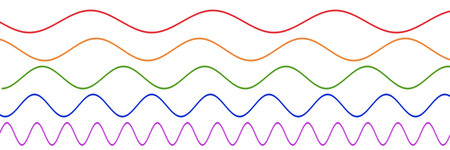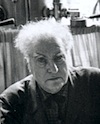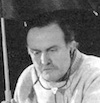On Thursday, April 28th, the Stedelijk
Museum (the Amsterdam Museum for modern art, that
continues to re-invent itself as the Temporary Stedelijk, due to
the ongoing hardships of a far too slowly proceeding re- & new-building)
in cooperation with Non-fiction,
opened up its galleries to an extra-ordinary event of sound-art and music.
For Hear
It! A Playlist for the Stedelijk Museum, a collection of performances,
installations and sound works was brought together, that only too rarely,
if ever, can all be experienced in one place and on the same evening. The
event included performances by Paul Panhuysen, Carl Michael von Hausswolff,
Claron McFadden, Sarah van Sonsbeeck, Hans Aarsman, Brandon LaBelle, Alog,
and Schola Cantorum, and sound works by Mark Bain, John Cage, Alvin Lucier,
La Monte Young, Dick Raaymakers, Gert-Jan Prins, Pierre Bastien and Allard
van Hoorn.
Hear It! was a big success. The public attendance and enthusiasm were overwhelming,
and, if one thing, the evening proved that the Amsterdam Stedelijk Museum,
whether temporary or not, is a marvelous setting for great sound art and
great music. Amsterdam deserves (and needs!) a 'happily noisily' Stedelijk.
So let's make that regularly, not just 'temporarily'.
It was an honor and a pleasure to introduce this very special evening,
in the museum's Auditorium. For those who were not there on Thursday at 20h: below is
the - illustrated - text of my introduction, complete & unabridged.
11 min read 🤓
Hear It! (Sound - Art - Music)
april 30, 2011.
"Dames en Heren, Ladies and Gentlemen,
The title of this fine evening in the Second Temporary Stedelijk Museum for Modern and Contemporary Art/Design of our beautiful city is unequivocal.
->Hear It!
You have come here this evening to hear.
You have come here to listen.
Even more so: you have come to listen to art.
Which, after many, many years of art in sound, and of sound in art, still is not all that usual. Not in a museum. This is an undeniable fact. A curious fact, indeed. For I am far from being alone in the conviction, that a considerable number of the great works of Western art of – let's say – the second half of the 20th century actually were 'painted in sound'.
That nevertheless our museums for modern art remain 'silent places', has many reasons. Among these there are historical reasons, cultural reasons, economical reasons, even political reasons.
There also are practical reasons.
Among the practical reasons, there is the physical nature of sound. As you all will be too well aware, it is pretty hard to tie sounds down. Sound is even worse than gas: there is no way that you can keep a sounding message in a bottle. Sound creeps around every little corner, it passes through ceilings, bumps through floors and even swooshes right through walls, as if it were a ghost.
Therefore, when you do listen to art in a museum, in many cases you do so through headphones. It is only in special cases, though, that sonic art is intended to be experienced by headphones. Most sound & most sound art really wants and needs to be free...
So then, what is sound?
Here is a definition:
'Sound is a sequence of waves of pressure that propagates through compressible media such as air or water.' (Sound can propagate also through solids, but there the propagation is a little more complicated.)
This is what makes sound different from light. Also light travels in waves. But these are a different kind of waves. In physics they are called electromagnetic waves. Electromagnetic waves do not need a medium for propagation. That is why light also travels through a vacuum. It is why at night we see the stars, and even are able to detect evidence of things that came about as long ago as a 'big bang', that blasted all of us into existence.
In a vacuum, however, there is no sound. Sound waves need a medium to pass through. That's why we maybe can see, but we cannot hear that 'big bang'.
At least, not directly.
The following animation illustrates how sound propagates through air. ( * )

The little dots represent air molecules. And, contrary to what you might think to see, the little dots are not in a continuous movement from the left to the right, or from the right to the left. If you try and focus on one of the dots, you will become aware of the fact that each of them actually is oscillating. It is quickly moving back-and-forth. Each dot thus imitates the back-and-forth movement of the red line. Which might, for example, be the cone of a loudspeaker.
It is this movement that then is moving across through the air.
In order for us to hear these waves of varying pressure, these sound waves, they have to be in a certain range. The human ear is only able to hear sound with frequencies between about 20 Hz and 20,000 Hz.

The pressure waves that correspond to most of the sounds that surround us are very complex. Though we know from physics, that all waves can be built up by adding together a lot of very simple ones (like those represented by the colored lines in the drawing), most sounds are very complex, because the movements that set the air in motion are almost always very complex.
These complex movements continuously, every single second of our life, literally tickle our ears. And though we can, quite easily shut out all the light by closing our eyes, it is not an easy thing to 'close your ears'. Nature does not want us to. Therefore, in order to stop hearing, you'll have to stuff things in your auditory canals, to damp the pressure waves. And even when you do: you may hear less, but – unless you are deaf - did you really ever, ever, hear nothing at all?
Inside your ear, the pressure waves, the sound waves, are transformed into nerve impulses. These then are transferred to your brain.
Here is a short uTube that, schematically, describes how our hearing works.
The effects of hearing sound are various and sometimes curious.
Sound is an integral and very important part of the world around us. It is the carrier for all of the spoken languages, that we use to communicate.
Sound continuously is drawing our attention to the things that happen around us, or that are about to happen.
It warns us for potential dangers.
In short: sound conveys meaning about the world, and our brains are continuously trying to make sense out of all that we hear.
How precisely a brain does this 'making sense’, continues to be quite something of a mystery, despite all of the efforts of scientists specializing in interesting studies like those of psychoacoustics or cognitive neuroscience.

The effects that sound may have on you are manifold. Everybody knows that firsthand, from personal experience. Sound, quite literally, moves you. Its impact is often very physical. Sound acts on your body. Sound can make you sick. It can make your blood pressure rise or fall. It changes the rate of your heart beat.
Sound also very often has a great emotional impact.
Sounds can strongly influence your mood.
They can irritate you, or make you whistle.
When you are happy, they have the power to make you even happier.
When you are sad, they sometimes make you even sadder.
And when we think about sound and moods, about sound and emotion, almost all of us will immediately think of music.
So then, what is music?
All music, of course, is sound.
Although our notion of and ideas about 'music' have been and still are constantly changing, there will be but very few among us that will insist on also the converse being true: that all sound is music (as opposed to 'can be' or 'can be used as part of').
Deeming all sound to be 'music' makes little (common) sense.
When someone tells you: 'Hey, listen! I hear music!', in almost all cases it will be pretty much excluded that she means the loud and chaotic soundings of the construction works that are going on next door.
 The
French-American composer Edgar
Varèse, who was one of the first early 20th century composers
to incorporate in his work, in a crucial way, sounds and sound sources that
– at the time – were by pretty much all listeners considered as being definitely non-musical,
said that to him music was 'organized sound'. It is a quote that
since – unfortunately mostly taken out of its context - has been repeated
again and again. Many nowadays take it as a definition of 'music'.
The
French-American composer Edgar
Varèse, who was one of the first early 20th century composers
to incorporate in his work, in a crucial way, sounds and sound sources that
– at the time – were by pretty much all listeners considered as being definitely non-musical,
said that to him music was 'organized sound'. It is a quote that
since – unfortunately mostly taken out of its context - has been repeated
again and again. Many nowadays take it as a definition of 'music'.
 The
French researcher and composer Pierre
Schaeffer, who was at the origin of what has become known as musique
concrète (concrete music), spent much of his lifetime looking for a
novel framework for the organized sound of our world; a framework that would
bypass the traditional notions of rhythm, timbre, tone and tempo. But then,
in an
interview towards the end of his life, Schaeffer himself sighed that
- 'unfortunately' - it had taken him 'forty years to conclude
that – musically - nothing is possible outside DoReMi'.
The
French researcher and composer Pierre
Schaeffer, who was at the origin of what has become known as musique
concrète (concrete music), spent much of his lifetime looking for a
novel framework for the organized sound of our world; a framework that would
bypass the traditional notions of rhythm, timbre, tone and tempo. But then,
in an
interview towards the end of his life, Schaeffer himself sighed that
- 'unfortunately' - it had taken him 'forty years to conclude
that – musically - nothing is possible outside DoReMi'.
Schaeffer was very serious about this, though of course he was also exaggerating. But he was exaggerating, in order to make an important point.
Music, in the colloquial sense, is a very special kind of sound. And its ways of being special are very, very persistent. Just think of the traditional properties and parameters that it comes with: melodies, with sounds that have a - more or less - well-determined pitch: the tones; rhythm: the beat; the – more or less sympathetic – sounding together of tones: harmony (the word indeed already says it all)...
But just how special is this? Can not 'music', in the end, be anything you want it to be? And if not, then what is it? Is what we think of as 'music' not determined by the culture that we are born into, and by our education?
That quite obviously is partly so, and maybe it even is true for a very large part indeed.
But, on the other hand, there is quite compelling evidence that at the heart of this 'music' of ours, there is something innate and universal. That men and women, in a very precise sense, are musical animals. Which would explain, for example, why we do not know of even one example of a human culture that lacks some form of 'organized sound' that all of us will immediately recognize as being: music!
What then precisely this 'innate musicality' is, how it got to be there and what it is good for, these are very difficult questions indeed, that scientists, in relatively new fields of research like music cognition, have only just started to find some first snippets of answers to.
Throughout its history our (Western) notion of 'music' has been expanding, almost continuously. You all will know that a great number of our musical classics, at the time of their premiere, were considered as: not music.
Musical developments were very often quite directly related to technological developments: 'music' has always been, and still is, closely linked to technology.
In view of the dazzling, exponential, flight that our technology has taken over the past 150 years, it therefore is no wonder that 'the arts of sound' have long since broken out of their traditional boundaries, out of the boundaries set by 'music' in the traditional sense.
Artists, whether or not they think of themselves as 'musicians', have been pushing the borders of that what is possible to do with sound, outside and inside of what is generally thought of as 'music', further and further.
Technology gives us the means to do so.
We can capture sounds in recordings, reproduce them and transform them in any imaginable way. We can create sound from its atomic components, be it sonic grains, sine- or other waves, and synthesize whatever sound we are able to imagine. We can transmit and reproduce these sounds over any imaginable distance. Artists project sounds in all sorts of, artificial or existing, spaces, to investigate and exploit the relation between these spaces and that what we hear. They combine sounds with objects, with images. All traditional limitations of duration can be dropped. We can make a piece sound forever, without a beginning and without an end.
Even the sky, indeed, is no longer the limit.
All of this has given rise to a field of artistic work that nowadays often is referred to as 'sound art'. But when you try to grasp what would, sharply, distinguish 'sound art' from 'music', you will soon discover that the boundaries, if any, are pretty vague, to say the least.
It is sometimes said that 'sound art' is more concerned with space and with process, while 'music' is principally concerned with time.
Well, this is true.
But then again: it is not.
Maybe it is best to approach the question in a pragmatic way. Which is what most working artists will do.
 I
for one, will heartily underline one of the motto's of this evening. It
is a quote of Alvin
Lucier’s, one of whose quite wonderful works you will be able to experience
here tonight.
I
for one, will heartily underline one of the motto's of this evening. It
is a quote of Alvin
Lucier’s, one of whose quite wonderful works you will be able to experience
here tonight.
'I don't separate sound art from music,' Lucier said. 'I am one person; my ideas come from the same place.'
...
Dames en Heren, Ladies and Gentlemen,
Our universe, on its largest scale (that of stars, galaxies and beyond), as well as on its smallest possible, sub-quantum, scale, is in continuous movement. All is vibration. And though almost all of these vibrations, in one way or another, lay far beyond the quite limited range of that what we can hear, there is an old and well-tested, indeed a 'musical’, technique that we can apply in order to make any sort of vibration audible: we can 'transpose' any vibration, upwards or downwards, and thus bring it within the reach of our ears.
This makes it possible to even, in a way, hear what that 'big bang' sounded like. In a similar way we are able to hear the sound of the atoms and molecules that make up our cells and our DNA.
Thus the art of sounds continues to develop, on to something maybe even more general: an art of vibrations.
Art then will eventually be able to convince you, Dames en Heren, Ladies and Gentlemen, that not only we are all musical, but that, even more so, we all are music.
So, let’s go, let’s Hear It!
Thank you."
...
notes __ ::
(*) Animation courtesy of Dr. Dan Russell, Kettering
University. (Acoustics
and Vibration Animations website) [
^ ]
tags: Amsterdam, Stedelijk Museum, sound art, music
# .405.
comments for Hear It! (Sound-Art-Music) ::
|
Comments are disabled |